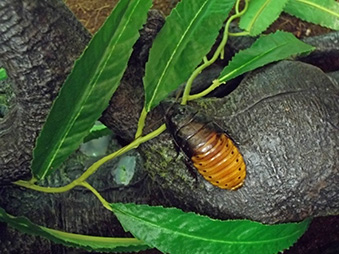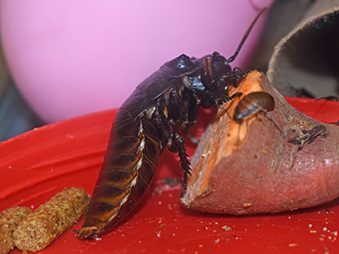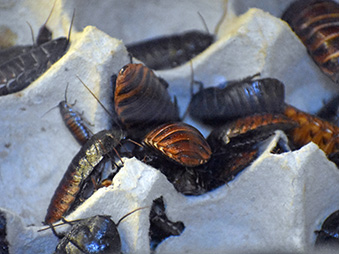Gromphadorhina portentosa | Madagascar Hissing Cockroach



Meet the Giants of the Forest Floor: Madagascar Hissing Cockroaches
Creepy? Maybe. Cool? Absolutely.
Our Madagascar Hissing Cockroaches, though unnamed, are some of the most fascinating invertebrates you’ll never hear coming—unless they decide to hiss! These large, wingless insects are native to the island of Madagascar, where they thrive in warm, humid forests, nestled in leaf litter and decaying logs.
Big Bugs, Big Personalities
Madagascar Hissing Cockroaches (or MH roaches) are among the largest cockroach species in the world, growing 2–4 inches long—that’s larger than a standard sticky note, which is only 3 inches! Their size is matched only by their personality and unique biology.
And for an insect? They live a surprisingly long life:
- 2–5 years, both in the wild and in human care—much longer than most insect species!
Masters of the Mic
Unlike your average roach, MH cockroaches are famous for their hissing sounds. They can make up to four different hisses to:
- Warn off predators
- Attract mates
- Establish dominance
- Communicate with other cockroaches
They don’t use vocal cords—the sound is made by forcing air through spiracles, tiny openings on the sides of their abdomen. It’s one of the few insect species on Earth that makes noise without wings or stridulation (rubbing body parts together).
Boys vs. Girls
You can actually tell males and females apart!
- Males have pronatal humps—horn-like bumps behind their heads used during sparring matches for dominance or territory.
- Femalesare smoother and lack these prominent humps completely or they are reduced greatly.
Tiny but Mighty: The Ecosystem Clean-Up Crew
Madagascar Hissing Cockroaches are detritivores, meaning they eat decaying plant and animal matter. In doing so, they help break down organic materials and return nutrients to the soil—an essential part of the nutrient cycle that supports healthy forests and plant life.
So, while they might look like something scary out of a sci-fi movie, they’re actually vital to the ecosystem.
Growing Up Roach: Lifecycle & Metamorphosis
MH roaches undergo incomplete metamorphosis—meaning their young, called nymphs, look like miniature adults (just without reproductive organs). Their growth process goes like this:
- The female carries her eggs internally in a long, yellow case called an ootheca.
- She births 15–40 live nymphs, which emerge completely white and soft.
- Over time, they darken and harden into their adult exoskeleton.
- Nymphs go through 6 molts (ecdysis) before reaching adulthood.
During a molt, they inflate their bodies to break free from their old exoskeleton—like stepping out of a tight jacket!
They can breed year-round but typically wait until warmer seasons to do so.
Sweet Treats & Zoo Life
At the zoo, these roaches munch on New World Primate Biscuits (for protein) and fresh produce, like oranges and sweet potatoes—which double as enrichment treats! This mimics their wild diet of rotting fruits, vegetables, insects, and even carrion (animals that have already passed away).
Although they’re currently not evaluated for conservation status, their populations are stable in the wild. Still, they play an essential role in educational programs and help people overcome their fear of bugs through understanding and respect.
Not a Pet
Yes, they’re hardy, quiet (most of the time), and popular in the invertebrate hobby—but we don’t recommend them as pets. Even low-maintenance animals like these require proper care, temperature regulation, and biosecurity.
Plus, wild animals—no matter how small—don’t belong in homes unless you have the money, time, and know-how.
- Please respect wildlife and always say NO to the exotic pet trade.
- If you would like to learn more about why domestic animals are the best pets for most people, check out the Not-a-Pet campaign!
Though they’re currently not viewable at all times to guests, these hissing cockroaches play an important role behind the scenes as ambassadors for invertebrate conservation. They're living proof that even “creepy crawlies” can have a HUGE impact on the planet.
Fact Sheet
Taxonomy
Genus: Gromphadorhina | Species: portentosa |
Kingdom: Animalia | Phylum: Arthropoda | Class: Insecta | Order: Blattodea | Family: Blaberidae |
Favorite Enrichment Type
Sweet potatoes and oranges!
Life Span
- In the Wild: 2 to 5 years
- In Human Care: 2 to 5 years
Diet
- In the Wild: A variety of decaying fruit and vegetable matter, carrion (deceased animals), various plants, and other bugs.
- At the Zoo: New World Primate Biscuits and fresh produce
Geographic Range
Madagascar
Habitat
Forests on the island of Madagascar.
Fun Fast Facts
- Size: Grows up to 4 inches—bigger than a sticky note!
- Sound: Can hiss loudly by pushing air through their spiracles—up to four different sounds!
- Males vs. Females: Males have “horns” used for sparring (called pronatal humps)
- Incomplete metamorphasis: Nymphs molt 6 times before adulthood in a process called ecdysis
- Ecosystem benefits: Eat decaying matter = excellent nutrient recyclers
- Lifespan: Live 2–5 years—a long time for an insect!
Status: Not Evaluated
International Union for Conservation of Nature (IUCN) – Not Evaluated
How to Find Us
Our hissing cockroach colony are all Ambassador Animals that live behind the scenes! If you would like to meet them in person, check out our daily, 11:00am Amphitheater Presentations at the Awareness Amphitheater, located just beyond the covered bridge. Amphitheater Presentations are dependent on the weather. Please check our activity board, behind the Admissions booth, before coming to see us!
